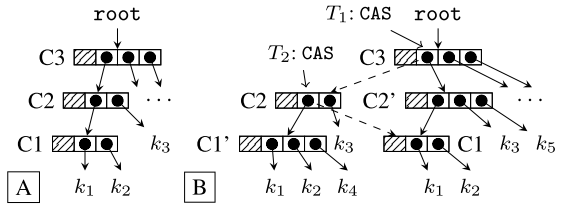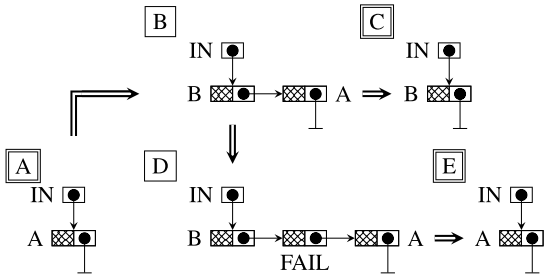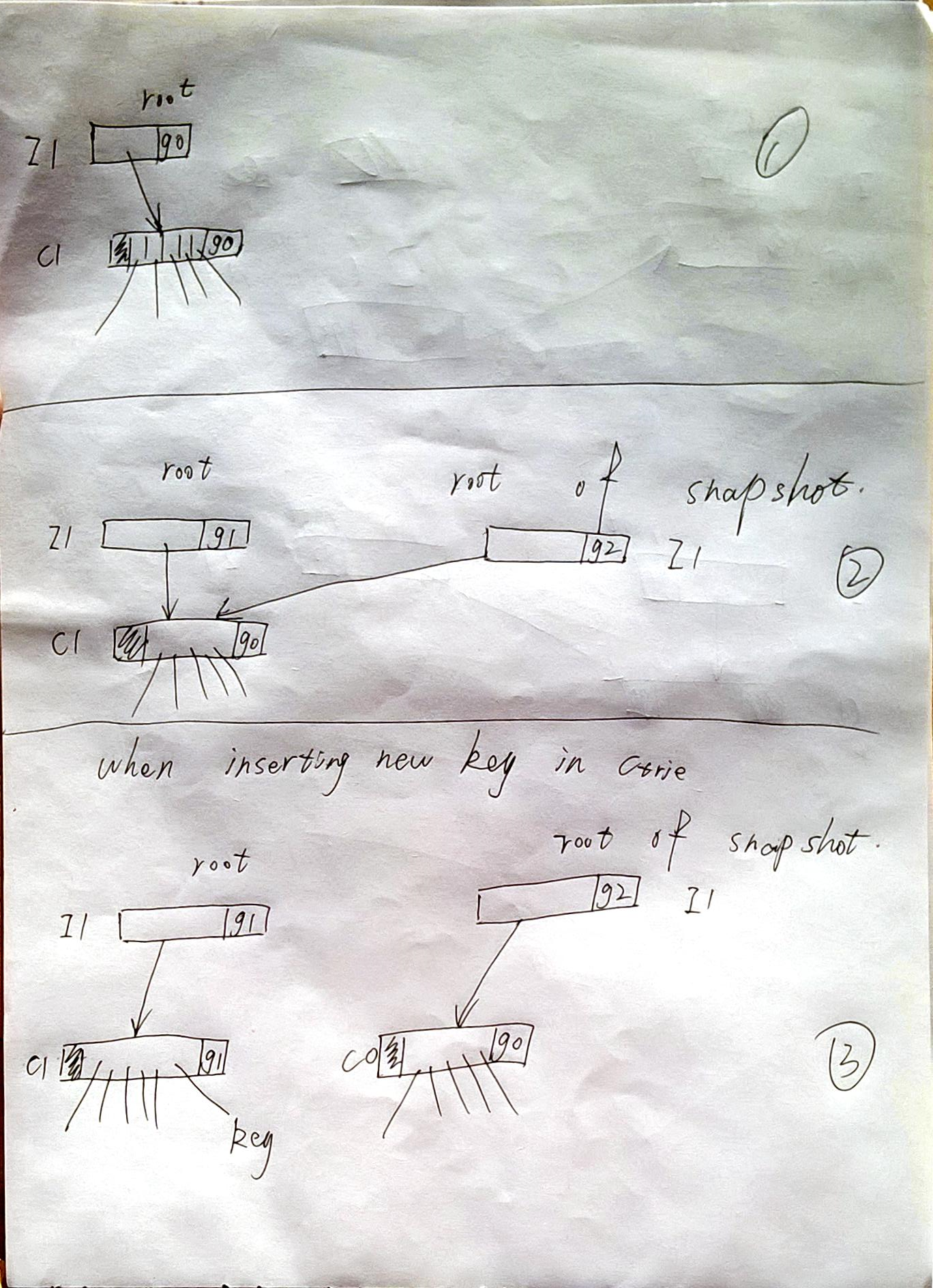Notes of Non-Blocking Snapshots Concurrent Tries
Hash tries
Hash tries (Hash array mapped tries) are trees composed of internal nodes and leaves. Leaves store key-value bindings.
Race

T1要插入k5到C2,与此同时T2要插入k4到C1。T1成功的进行了CAS,但是T2进行的CAS操作是在老的C2上,最后导致k4丢失。
这里的race类似于Non-blocking Binary Search Trees的情况,两个线程各自进行操作,就线程自己来看,所做的操作是正确的,但是相互不知道有race。
这个结构能否使用Non-blocking Binary Search Trees的方法(mark和flag)?
解决
引入各种中间结点。。。
Snapshot
size、iterator和clear不能简单的以lock-free的方式来实现,因为需要某一时刻的全局信息。基于atomic snapshot,这些操作可以高效和正确的得到结果。
当一个snapshot被创建时,root I-node被复制,并被设置为新的generation。这个generation count可以由每个I-node保存。当某些update操作检测到它gen比root老,它就创建带有最新gen的那个I-node的copy,并根据需要update parent。snapshot创建后最终的效果就是,当首次访问(update)那个leaf的时候,从root到leaf,整个path都被update。
这里用到的snapshot方法,我觉得本质上还是copy on write。
Race
创建snapshot的线程、读取了老的root且正在遍历并update的线程之间(插入操作的linearization point可能会先于snapshot的创建)。
GCAS (generation-compare-and-swap)
直接用CAS在这里并不可行,因为有gen,就需要同时比较新老数据,还有I-node和root的gen。
GCAS类似CAS,不同的地方是加入了I-node和root结点gen的比较。
| |
具体的操作是先不管gen的情况,把old Main node挂到new Main node的prev上,接着把new Main node挂到I-node,最后处理I-node下Main node的情况。

现在的问题是怎么update从root到leaf的path?
当遍历时遇到一个I-node,如果gen < startgen,那么就创建它的C-node和这个C-node下面所有I-node的copy,这个C-node下面其他类型的node(S-node)不copy。这样就update了从root到leaf的path。
RDCSS
问题又来了,其他I-node可以被创建copy,但是第一个I-node,即root,它并没有在C-node下面,如何创建新gen的root?
直接创建新gen root的copy,然后cas挂上去,这个方法并不好完成。因为只有当root和old I-node一致,且old I-node的main和old main一致(因为原文代码165行的地方,需要old main来构建新的I-node)时才行。
这里使用的RDCSS源自Harris提出的方法,类似GCAS。
| |
要注意的是:如果两个线程,一个GCAS对root I-node进行操作,另一个RDCSS对Ctrie的root成员进行操作,那么回导致死锁(为什么?与RDCSS中(C2的if进行比较以后,会不会有其他thread改变o1?)这个问题有关?)。
因此引入了ABORTABLE_READ。
A detail in RDCSS_Complete
在阅读源码的时候,想到这么一个问题,
| |
My previous doubt lies in line 711. The
oldmainis compared withexpectedmain. If they are reference to same main node, then doCAS_ROOT. Suppose thread A is executingRDCSS_Completeand just finished line 710. Thread B is inserting a key value pair at the mainnode of root. What if thread B changes theMainNodereference in the root into a new mainnode before thread A executeCAS_ROOT?
The doubt is unnecessary. Since thread A is executing
RDCSS_Complete, the root must beRDCSS_Descriptor. If Thread B want to insert at theMainNodeof root, it will read root first, find it’sRDCSS_Descriptorand callRDCSS_Completeto help thread A first. So Thread B can’t change theMainNodereference in the root directly.
(与Aleksandar Prokopec邮件的内容,就是问题和自己的理解,这里只是做个整理,不翻译了,其实是懒。。。)
Snashot
| |
snapshot()以后,实际上是产生了两个新的root I-node,其中一个替换Ctrie自己的root,另一个用于构成返回Ctrie,这个返回的Ctrie就是所需的snapshot。
从上面伪代码来看,可能会产生怀疑的是,snapshot()刚刚完成时,两个root I-node都是reference到同一个C-node。如果某个线程更改了root下的C-node,那snapshot中root下的C-node也被改,snapshot还有什么意思?
snapshot的中的东西不会被更改,具体的原因如下,注意看版本号,

换句话说,就是当没有update或access时,Ctrie和snapshot共享结点;但是如果Ctrie发生update或access,从root到访问位置的path就被copy和update了,snapshot里的不变。
| |
由于当计算snapshot的size或进行iterate时,snapshot是不变的,因此update涉及到的node是不必要的开销,因此使用旧的root,且把readonly设为true来构造snapshot。
References
- Concurrent Tries with Efficient Non-Blocking Snapshots, Aleksandar Prokopec, Nathan G. Bronson, Phil Bagwell, Martin Odersky
- Non-blocking Binary Search Trees, Faith Ellen, Panagiota Fatourou, Eric Ruppert, Franck van Breugel
- A Practical Multi-Word Compare-and-Swap Operation, Timothy L. Harris, Keir Fraser, Ian A. Pratt